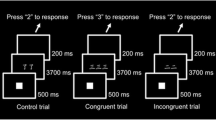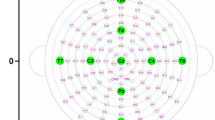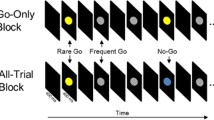Abstract
Rationale
Methylphenidate, the most common treatment of attention deficit hyperactivity disorder (ADHD), is increasingly used by healthy individuals as a “smart drug” to enhance cognitive abilities like attention. A key feature of (selective) attention is the ability to ignore irrelevant but salient information in the environment (distractors). Although crucial for cognitive performance, until now, it is not known how the use of methylphenidate affects resistance to attentional capture by distractors.
Objectives
The present study aims to clarify how methylphenidate affects distractor suppression in healthy individuals.
Methods
The effect of methylphenidate (20 mg) on distractor suppression was assessed in healthy subjects (N = 20), in a within-subject double-blind placebo-controlled crossover design. We used a visuospatial attention task with target faces flanked by strong (faces) or weak distractors (scrambled faces).
Results
Methylphenidate increased accuracy on trials that required gender identification of target face stimuli (methylphenidate 88.9 ± 1.4 [mean ± SEM], placebo 86.0 ± 1.2 %; p = .003), suggesting increased processing of the faces. At the same time, however, methylphenidate increased reaction time when the target face was flanked by a face distractor relative to a scrambled face distractor (methylphenidate 34.9 ± 3.73, placebo 26.7 ± 2.84 ms; p = .027), suggesting enhanced attentional capture by distractors with task-relevant features.
Conclusions
We conclude that methylphenidate amplifies salience of task-relevant information at the level of the stimulus category. This leads to enhanced processing of the target (faces) but also increased attentional capture by distractors drawn from the same category as the target.


Similar content being viewed by others
References
Advokat C, Scheithauer M (2013) Attention-deficit hyperactivity disorder (ADHD) stimulant medications as cognitive enhancers. Front Neurosci 7:82
Agay N, Yechiam E, Carmel Z, Levkovitz Y (2014) Methylphenidate enhances cognitive performance in adults with poor baseline capacities regardless of attention-deficit/hyperactivity disorder diagnosis. J Clin Psychopharmacol 34:261–265
Baier B, Karnath HO, Dieterich M, Birklein F, Heinze C, Muller NG (2010) Keeping memory clear and stable—the contribution of human basal ganglia and prefrontal cortex to working memory. J Neurosci 30:9788–9792
Clatworthy PL, Lewis SJ, Brichard L, Hong YT, Izquierdo D, Clark L, Cools R, Aigbirhio FI, Baron JC, Fryer TD, Robbins TW (2009) Dopamine release in dissociable striatal subregions predicts the different effects of oral methylphenidate on reversal learning and spatial working memory. J Neurosci 29:4690–4696
Cools R, Robbins TW (2004) Chemistry of the adaptive mind. Philos Transact A Math Phys Eng Sci 362:2871–2888
Crofts HS, Dalley JW, Collins P, Van Denderen JC, Everitt BJ, Robbins TW, Roberts AC (2001) Differential effects of 6-OHDA lesions of the frontal cortex and caudate nucleus on the ability to acquire an attentional set. Cereb Cortex 11:1015–1026
del Campo N, Fryer TD, Hong YT, Smith R, Brichard L, Acosta-Cabronero J, Chamberlain SR, Tait R, Izquierdo D, Regenthal R, Dowson J, Suckling J, Baron JC, Aigbirhio FI, Robbins TW, Sahakian BJ, Muller U (2013) A positron emission tomography study of nigro-striatal dopaminergic mechanisms underlying attention: implications for ADHD and its treatment. Brain 136:3252–3270
Demakis GJ (2003) A meta-analytic review of the sensitivity of the Wisconsin Card Sorting Test to frontal and lateralized frontal brain damage. Neuropsychology 17:255–264
Desimone R, Duncan J (1995) Neural mechanisms of selective visual attention. Annu Rev Neurosci 18:193–222
Dias R, Robbins TW, Roberts AC (1996) Dissociation in prefrontal cortex of affective and attentional shifts. Nature 380:69–72
DuPaul GPT, Anastopoulos A (1998) ADHD rating scale—IV: checklists, norms and clinical interpretation. Guilford, New York
Elliott R, Sahakian BJ, Matthews K, Bannerjea A, Rimmer J, Robbins TW (1997) Effects of methylphenidate on spatial working memory and planning in healthy young adults. Psychopharmacology (Berlin) 131:196–206
Fallon SJ, Williams-Gray CH, Barker RA, Owen AM, Hampshire A (2013) Prefrontal dopamine levels determine the balance between cognitive stability and flexibility. Cereb Cortex 23:361–369
Faraone SV, Buitelaar J (2010) Comparing the efficacy of stimulants for ADHD in children and adolescents using meta-analysis. Eur Child Adolesc Psychiatry 19:353–364
Frank MJ (2011) Computational models of motivated action selection in corticostriatal circuits. Curr Opin Neurobiol 21:381–386
Frank MJ, O’Reilly RC (2006) A mechanistic account of striatal dopamine function in human cognition: psychopharmacological studies with cabergoline and haloperidol. Behav Neurosci 120:497–517
Greely H, Sahakian B, Harris J, Kessler RC, Gazzaniga M, Campbell P, Farah MJ (2008) Towards responsible use of cognitive-enhancing drugs by the healthy. Nature 456:702–705
Gruber AJ, Dayan P, Gutkin BS, Solla SA (2006) Dopamine modulation in the basal ganglia locks the gate to working memory. J Comput Neurosci 20:153–166
Hampshire A, Owen AM (2006) Fractionating attentional control using event-related fMRI. Cereb Cortex 16:1679–1689
Hampshire A, Duncan J, Owen AM (2007) Selective tuning of the blood oxygenation level-dependent response during simple target detection dissociates human frontoparietal subregions. J Neurosci 27:6219–6223
Jacques C, Rossion B (2004) Concurrent processing reveals competition between visual representations of faces. Neuroreport 15:2417–2421
Jan RK, Lin JC, McLaren DG, Kirk IJ, Kydd RR, Russell BR (2014) The effects of methylphenidate on cognitive control in active methamphetamine dependence using functional magnetic resonance imaging. Front Psychiatry 5:20
Keysers C, Perrett DI (2002) Visual masking and RSVP reveal neural competition. Trends Cogn Sci 6:120–125
Kim MS, Cave KR (1999) Top-down and bottom-up attentional control: on the nature of interference from a salient distractor. Percept Psychophys 61:1009–1023
Koelega HS (1993) Stimulant drugs and vigilance performance: a review. Psychopharmacology (Berlin) 111:1–16
Lamy D, Tsal Y, Egeth HE (2003) Does a salient distractor capture attention early in processing? Psychon Bull Rev 10:621–629
Langner O, Dotsch R, Bijlstra G, Wigboldus DHJ, Hawk ST, van Knippenberg A (2010) Presentation and validation of the Radboud Faces Database. Cogn Emot 24:1377–1388
Laubrock J, Engbert R, Kliegl R (2005) Microsaccade dynamics during covert attention. Vis Res 45:721–730
Linssen AM, Sambeth A, Vuurman EF, Riedel WJ (2014) Cognitive effects of methylphenidate in healthy volunteers: a review of single dose studies. Int J Neuropsychopharmacol 17(6):961–977
Mehta MA, Owen AM, Sahakian BJ, Mavaddat N, Pickard JD, Robbins TW (2000) Methylphenidate enhances working memory by modulating discrete frontal and parietal lobe regions in the human brain. J Neurosci 20:RC65
Moustafa AA, Sherman SJ, Frank MJ (2008) A dopaminergic basis for working memory, learning and attentional shifting in parkinsonism. Neuropsychologia 46:3144–3156
Pauls AM, O’Daly OG, Rubia K, Riedel WJ, Williams SC, Mehta MA (2012) Methylphenidate effects on prefrontal functioning during attentional-capture and response inhibition. Biol Psychiatry 72:142–149
Pietrzak RH, Mollica CM, Maruff P, Snyder PJ (2006) Cognitive effects of immediate-release methylphenidate in children with attention-deficit/hyperactivity disorder. Neurosci Biobehav Rev 30:1225–1245
Posner MI, Petersen SE (1990) The attention system of the human brain. Annu Rev Neurosci 13:25–42
Redgrave P, Prescott TJ, Gurney K (1999) Is the short-latency dopamine response too short to signal reward error? Trends Neurosci 22:146–151
Roberts AC, De Salvia MA, Wilkinson LS, Collins P, Muir JL, Everitt BJ, Robbins TW (1994) 6-Hydroxydopamine lesions of the prefrontal cortex in monkeys enhance performance on an analog of the Wisconsin Card Sort Test: possible interactions with subcortical dopamine. J Neurosci 14:2531–2544
Rogers RD, Blackshaw AJ, Middleton HC, Matthews K, Hawtin K, Crowley C, Hopwood A, Wallace C, Deakin JF, Sahakian BJ, Robbins TW (1999) Tryptophan depletion impairs stimulus-reward learning while methylphenidate disrupts attentional control in healthy young adults: implications for the monoaminergic basis of impulsive behaviour. Psychopharmacology (Berlin) 146:482–491
Sheehan DV, Lecrubier Y, Sheehan KH, Amorim P, Janavs J, Weiller E, Hergueta T, Baker R, Dunbar GC (1998) The Mini-International Neuropsychiatric Interview (M.I.N.I.): the development and validation of a structured diagnostic psychiatric interview for DSM-IV and ICD-10. J Clin Psychiatry 59(Suppl 20):22–33, quiz 34–57
Smith ME, Farah MJ (2011) Are prescription stimulants “smart pills”? The epidemiology and cognitive neuroscience of prescription stimulant use by normal healthy individuals. Psychol Bull 137:717–741
Sreenivasan KK, Curtis CE, D’Esposito M (2014) Revisiting the role of persistent neural activity during working memory. Trends Cogn Sci 18:82–89
Swanson J, Gupta S, Lam A, Shoulson I, Lerner M, Modi N, Lindemulder E, Wigal S (2003) Development of a new once-a-day formulation of methylphenidate for the treatment of attention-deficit/hyperactivity disorder: proof-of-concept and proof-of-product studies. Arch Gen Psychiatry 60:204–211
Turner DC, Robbins TW, Clark L, Aron AR, Dowson J, Sahakian BJ (2003) Cognitive enhancing effects of modafinil in healthy volunteers. Psychopharmacology (Berlin) 165:260–269
van der Schaaf ME, Fallon SJ, Ter Huurne N, Buitelaar J, Cools R (2013) Working memory capacity predicts effects of methylphenidate on reversal learning. Neuropsychopharmacology 38(10):2011–2018
van Schouwenburg M, Aarts E, Cools R (2010) Dopaminergic modulation of cognitive control: distinct roles for the prefrontal cortex and the basal ganglia. Curr Pharm Des 16:2026–2032
van Schouwenburg MR, Zwiers MP, van der Schaaf ME, Geurts DE, Schellekens AF, Buitelaar JK, Verkes RJ, Cools R (2013) Anatomical connection strength predicts dopaminergic drug effects on fronto-striatal function. Psychopharmacology (Berlin) 227:521–531
Volkow ND, Wang GJ, Fowler JS, Logan J, Jayne M, Franceschi D, Wong C, Gatley SJ, Gifford AN, Ding YS, Pappas N (2002) “Nonhedonic” food motivation in humans involves dopamine in the dorsal striatum and methylphenidate amplifies this effect. Synapse 44:175–180
Volkow ND, Wang GJ, Fowler JS, Telang F, Maynard L, Logan J, Gatley SJ, Pappas N, Wong C, Vaska P, Zhu W, Swanson JM (2004) Evidence that methylphenidate enhances the saliency of a mathematical task by increasing dopamine in the human brain. Am J Psychiatry 161:1173–1180
Volkow ND, Wang GJ, Newcorn J, Telang F, Solanto MV, Fowler JS, Logan J, Ma Y, Schulz K, Pradhan K, Wong C, Swanson JM (2007) Depressed dopamine activity in caudate and preliminary evidence of limbic involvement in adults with attention-deficit/hyperactivity disorder. Arch Gen Psychiatry 64:932–940
Wilens TE (2008) Effects of methylphenidate on the catecholaminergic system in attention-deficit/hyperactivity disorder. J Clin Psychopharmacol 28:S46–S53
Acknowledgments
The authors gratefully acknowledge The Netherlands Organization for Scientific Research (NWO) VICI grant number 453-09-002 and the James McDonnell scholar award.
Conflict of interest
No commercial sponsors were involved in this study. The author(s) declared the following potential conflicts of interest with respect to the research, authorship, and/or publication of this article: Dr Buitelaar has been for the past 3 years a consultant to, member of the advisory board of, and/or speaker for Janssen Cilag BV, Eli Lilly, Bristol-Myers Squibb, Schering-Plough, UCB, Shire, Novartis, and Servier. He is neither an employee of nor a shareholder in any of these companies. He receives no other financial or material support, including expert testimony, patents, and royalties. The other authors have no conflict of interest to report.
Author information
Authors and Affiliations
Corresponding author
Rights and permissions
About this article
Cite this article
ter Huurne, N., Fallon, S.J., van Schouwenburg, M. et al. Methylphenidate alters selective attention by amplifying salience. Psychopharmacology 232, 4317–4323 (2015). https://doi.org/10.1007/s00213-015-4059-y
Received:
Accepted:
Published:
Issue Date:
DOI: https://doi.org/10.1007/s00213-015-4059-y




